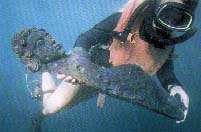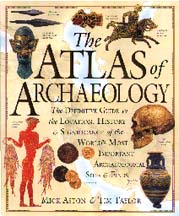|
________________
CM . . . .
Volume VI Number 2 . . . . September 17, 1999
excerpt: Metallurgy is important to archaeologists because it often indicates the beginning of class differentiation and status in society, becoming more apparent in the sophisticated societies of the Bronze Age. At Varna, such a wide-ranging and abundant collection of artifacts has been found that archaeologists can suggest how societies may have been organized from the layout of the burials. Several different types of grave have been identified, based on the way the body was laid, lying either on its back or on its side, the types of decoration, and the amount of metalwork found in each one. For example, only a few of the burials contained gold scepters, which are interpreted as symbols of power and high status, while some of the graves contained no gold at all.  Archaeology buffs will delight in this impressive body of work, the joint effort of Mick Aston, a
Professor of Archaeology at the University of Bristol, and Tim Taylor, a writer and producer of
television programs on archaeology. The authors' contagious enthusiasm for their chosen field
will even hook those readers who are novices to the world of unearthing the past.
Archaeology buffs will delight in this impressive body of work, the joint effort of Mick Aston, a
Professor of Archaeology at the University of Bristol, and Tim Taylor, a writer and producer of
television programs on archaeology. The authors' contagious enthusiasm for their chosen field
will even hook those readers who are novices to the world of unearthing the past.
The book is divided into two main parts: the first (and larger) of the sections is comprised of 11 chapters and showcases various ages in history and arranged chronologically from the time of the earliest hunter-gatherers to the Industrial Age. The second part includes a gazetteer, an index, a glossary and a bibliography. As readers join the authors on a "journey of discovery through key archaeological sites," they will examine and interpret evidence left behind by preceding generations. Just as a detective must piece together evidence left at the scene of a crime, so must archaeologists find the relationship between artifacts found at an excavation site and the type of climate, plants and animals that existed at the time. Each chapter begins with general information about a specific age. A large world map indicates excavation sites where artifacts from that period were found. Soft pastel-coloured sketches depict family life-- the homes, food, rituals, tools, etc., while photographs of artifacts show actual finds. Both are accompanied by explanatory paragraphs. Specific archaeological sites are highlighted in the remainder of the chapter. Geophysical maps, excavation plans, diagrams and plenty of photographs are provided. In some cases, small boxes list "site evidence" while "conclusion" boxes interpret the finds. Where several objects of the same type, but of different ages, are compared (glass or pottery, for example), the key characteristics of each sample appear under the accompanying photos. The last chapter of Part One explains the various techniques used to discover potential excavation sites and to preserve and date artifacts. Topics include several types of geophysical surveying, ground radar, aerial photography, posthole analysis and radiocarbon dating. Fair warning - this chapter is very technical. In the gazetteer in Part Two, sites are numbered and colour-coded according to the period to which they belong. The numbers correspond to gazetteer listings which give the location, the type of site (e.g. Inuit settlement, ceremonial centre), the time period and a brief description of site details. Expertly researched, this book contains a wealth of information. With an obvious passion for archaeology, the authors share their vast knowledge, but even with the use of considerable text to explain archaeological terms and scientific concepts, much of the vocabulary is far too difficult for all but the best readers in the upper elementary grades. However, the inclusion of maps, sketches, detailed full-colour drawings of sites as they would have appeared originally, and fantastic photographs more than makes up for the difficult vocabulary so that all readers will, in some way, benefit from examining this book. With its attractive layout and its incredibly well-researched information. this book is a fascinating read. Its greatest strength is its ability to transport readers back in time and to shape their understanding of the lifestyles of previous generations, for, in unearthing the past, we can better understand the present. Highly recommended. Gail Hamilton is a teacher-librarian at Bird's Hill School in East St. Paul, MB.
To comment on this title or this review, send mail to cm@umanitoba.ca.
Copyright © the Manitoba Library Association.
Reproduction for personal use is permitted only if this copyright notice
is maintained. Any other reproduction is prohibited without
permission.
Published by
TABLE OF CONTENTS FOR THIS ISSUE -September 17, 1999.
AUTHORS |
TITLES |
MEDIA REVIEWS |
PROFILES |
BACK ISSUES |
SEARCH |
CMARCHIVE |
HOME
|
